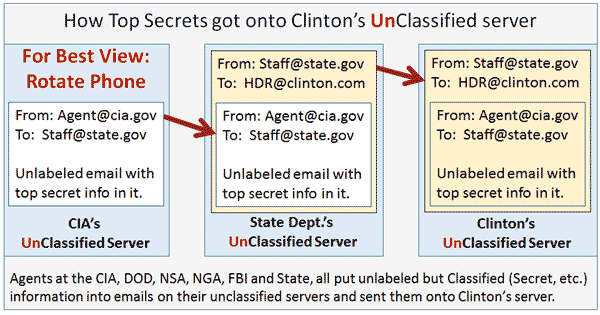How emails reached Clinton from the other agencies
Most emails to Clinton’s seemed to come through her staff, so the figure below shows how that worked. The CIA agent uses an unclassified server to send an email containing classified information to Clinton’s staff. It lands on the unclassified State Department server. So now there are two copies (the “sent” email on the CIA server and the “received” email on the State Department server), both in violation of that same security regulations.
Then Clinton’s staff person forwards the email to Clinton. Now Clinton’s server has a security violation, even though she hasn’t seen the email yet.

At this point Clinton has done nothing wrong. It is NOT against government policy for Clinton to have a private email account, and she has put nothing classified on her server.
But the CIA agent has tricked her staff person into putting classified info on Clinton’s server by sending unmarked classified info through the unclassified system—a double indication that the info is unclassified and fine to forward to Clinton.
Excuses: Why were seasoned intelligence professionals cheating?
Mostly they weren’t. There were only eight such Top Secret email chains in four years (a few more Secret ones and quite a few Confidential ones). All told less than 1% of her emails were classified at the time they were sent. But still this is too many to just be due to slip-ups.
“It’s common knowledge that the classified communications system is impossible and isn’t used,” said one former high-level Justice Department official.” —Washington Post
According to the FBI report (p. 22), “During FBI interviews, the authors of these e-mails provided … reasons for sending the e-mails on unclassified systems.” The FBI summarized some of their answers as follows (p. 23)
- “To quickly coordinate public affairs responses.”
- “Because of the need to quickly elevate information at times when the intended recipients did not all have immediate access to classified e-mail accounts.”
- “The right method of communication was whichever method allowed for the fastest possible dissemination of the message. He also stated that information he received
from other USG agencies was ‘technically probably classified’ but that ‘you can’t do business that way.’ “
The FBI also notes that it was “common practice” to “carefully word e-mails on UNCLASSIFIED networks so as to avoid sensitive details.” Apparently the classified system is quite inconvenient and often a slow way to get information to someone.
[social_warfare]
Why didn’t Clinton realize the information was classified?
As explained in the Dennis Ross example above, most (if not all) of the classified information was sent Clinton by experienced intel professionals, but it was sent through the unclassified email system and had no classification markings.
Classification markings really matter if there’s an emergency and you have to send classified info on an unclassified system. That’s when the sender of the info (who knows best if the info’s classified) really should use a “a header or footer, indicating that they were classified [FBI p. 20].”
 The mysterious “(C)” marking. Yes, three times in four years, Clinton got emails containing paragraphs marked with a “(C)”, which means Confidential, but all of the Secret and Top Secret email had no classification markings whatsoever. And Confidential is the least secret. In fact we know one of these three was a reminder to “Call to President [Joyce] Banda” of Malawi. As it turns out this was a condolence call because the former president had just died. Clinton claimed this email “could NOT reasonably be expected to cause damage to the national security” if released.
The mysterious “(C)” marking. Yes, three times in four years, Clinton got emails containing paragraphs marked with a “(C)”, which means Confidential, but all of the Secret and Top Secret email had no classification markings whatsoever. And Confidential is the least secret. In fact we know one of these three was a reminder to “Call to President [Joyce] Banda” of Malawi. As it turns out this was a condolence call because the former president had just died. Clinton claimed this email “could NOT reasonably be expected to cause damage to the national security” if released.
When the FBI asked the State Dept if these three email chains were classified at the time they were sent, the State Department did not reply. [FBI Report, p.20]
Not a single email had headers or footers indicating they were classified. None had any indication of being Secret or Top Secret, and only three out of about 100 had the tiniest indication (a paragraph marked “C”) that they were Confidential (although actually over-classified).
When the FBI asked Clinton why she thought the information was unclassified, she stated that it had come from “experienced foreign service professionals and she had no reason to doubt their judgement and ability to handle classified information.” So what else would she think? And that’s why she initially told the public, “I never sent or received any classified material [Feb 4, 2016].”
Clinton never wanted her server to receive classified information
Classified information is usually sent from inside a Sensitive Compartmented Information Facility (SCIF). Clinton’s office was actually inside a SCIF so she could not even bring her Blackberry into her office, and couldn’t send or receive emails there. But she did have classified phones and a classified fax. She also had a SCIF at her home and only she had the combination.
All this means she was completely aware that her Blackberry and email server were not for classified information. She respected this and thought others did as well.
Q: Was her server “more unclassified” than the others?
A: Not in any legal sense.
Q: If she had used here SSHC@state.gov email would that have solved problem.
Ironically, if Clinton had used SSHC@state.gov instead of her private email, as the Republicans say she should have, it would have made no difference regarding the FBI’s primary complaint. Every Classified email that the FBI found on her home server would have been found in her email account on the unclassified State Dept Server. Every security violation would still have occurred.
Q: Was she hiding government documents?
A: Just the opposite. She made sure all of her government emails came from or were sent to (or CC’d to) State Department email accounts where they were preserved — for a while. They were supposed to be preserved permanently along with all of her staff’s emails, but the State Department lost most of them. Fortunately Clinton was able to provide the vast bulk of those that the State Department had lost. And she did.

